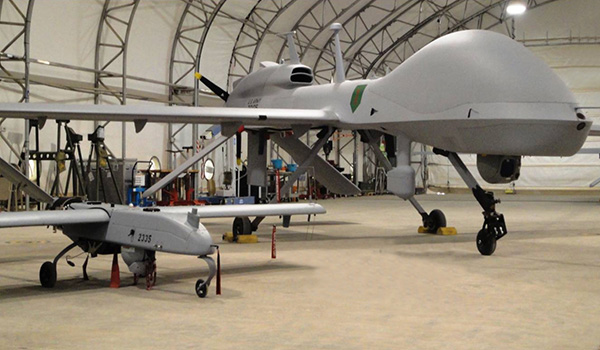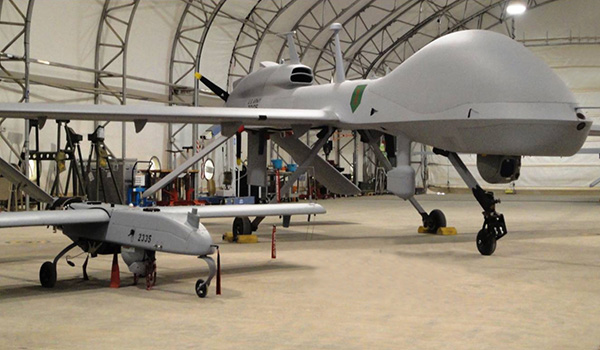
Combat Readiness Center / By CW5 (Ret.) Michael J. Carroll: Since 9/11, the world of unmanned aircraft systems has rapidly evolved to meet the needs of combatant commanders and our Army as a whole. Once a unique specialty of Military Intelligence, UAS are now fielded to combat aviation brigades (CABs) and brigade combat teams (BCTs) and utilized from squad/platoon levels up to division and corps.

An RQ-7 Shadow (left) and MQ-1C Gray Eagle at Fort Huachuca, AZ. / U.S. ARMY PHOTO BY 2-13 AVN PUBLIC AFFAIRS
Operating in potentially high-threat environments without risk to human crews, UAS are proving indispensable as a combat multiplier and continue to save lives due to their invaluable surveillance and reconnaissance capabilities. Yet, the unfettered demand, rapid growth and expedited training of UAS formations during the past decade has come at a price, namely inadequate integration into the fabric and institutions of Army Aviation.
To date, approximately 90 percent of the 2 million hours flown by the Army UAS fleet has been logged in combat. The procedures used while operating in a combat environment have been tested and fine-tuned, with missions originating in some of the busiest airports and most complex airspace in theater alongside all types of manned aircraft. Adopted and adapted appropriately, these lessons learned will prove indispensable in developing safe flying protocols within the United States. Even so, some of our home station airfields and training airspace rival deployed capacity and complexity due to the high density of manned, unmanned, fires and joint airspace “sharers.”
Even more significantly, we must have the utmost concern for UAS accidents occurring in our national airspace. While Army Aviation has and will continue to operate safely across CONUS, the relative newness of Army UAS requires careful attention to operating and safety procedures to avoid a serious incident while conducting home station operations. Failure to safely integrate UAS into the national airspace could delay or seriously affect future UAS integration and, ultimately, unit readiness.
Integration
Through the Aviation Restructure Initiative, Gray Eagle and Shadow units are fielding and incorporating into the CABs and resident armed reconnaissance squadrons. This process facilitates integration of UAS into formerly manned-only aviation organizations with detailed risk management and mission approval processes, as well as proven and combat-tested aviation safety cultures. However, UAS units will still continue to operate and be fielded to BCTs that might lack organic aviation safety expertise. We must assume responsibility for the training, safety and readiness of these formations. In addition, the Raven and Puma small UAS are embedded in tactical units down to company level and also require a culture of safe and effective operations, which we can pass along as part of the division team.
Regardless of where UAS fall within our overall formations, aviation leaders must address common issues like airspace restrictions, training shortfalls, crew currency and proficiency, aviation maintenance practices and policies, and risk mitigation and acceptance in mission planning. Currently, our most significant UAS training gap is in individual and collective unit proficiency. Execution of quality training is the bedrock of our operations, and UAS units are no different. We must train and operate UAS according to aircrew training programs in commanders’ guides and in combined arms training opportunities with organic ground units.
A recent analysis of FY15 Shadow platoon flying hour programs indicated 75 percent of platoons flew only around 100 hours… for the entire year! That is only about a quarter of the minimum 440 annual training flight hours required to be considered collectively proficient. Limited peacetime training at home station also correlated with higher mishaps compared to deployed unit OPTEMPO.
Despite lags in training, a review of recent accident numbers proves organizations operating UAS are making great strides in reducing mishaps. During FY15, a total of 46 Class A-D unmanned accidents were reported across the Army, compared to 69 in FY 2014 – nearly a 33 percent reduction. Four of those accidents were Class A, with the Gray Eagle accounting for three. In FY14, the Army experienced nine Class A UAS accidents, so FY15’s total was a 56-percent reduction from the prior year.
Of all Class A-D unmanned accidents during FY15, 61 percent (28) occurred CONUS, and 39 percent (18) occurred OCONUS. The Shadow platform was reported in 87 percent (40) of FY15’s Class A-D accidents, compared to 80 percent (55) of 69 in FY14. The leading causal factor for Shadow mishaps during FY15 was materiel failure at 53 percent (21), compared to 62 percent (34) in FY14. Five Gray Eagle Class A and B accidents were reported in FY15, compared to five Class A accidents during FY14. As with the Shadow, the leading causal factor cited in FY15’s Gray Eagle mishaps was materiel failure; however, human error and environment were the top two reported factors during FY14.
Where Do We Go From Here?
The first step is getting our UAS units in flyable airspace and into the air. There will likely be some special conditions at every installation, with airspace worked through the local range control and/or the Federal Aviation Administration as part of their Certificate of Operating Authority processes. Secondly, we must increase use of the Universal Mission Simulator (UMS) with the new Universal Ground Control Station. The UMS is designed to provide high-fidelity simulation that supports individual and crew aircraft and payload operator tasks. Thirdly, we must vigorously track and report training and sustainment readiness on unit status reports.
Finally, we must find new and innovative ways to share limited and valuable training ranges and airspace. We no longer have the luxury of assigning a Shadow platoon to a single training range for the entire week. Training missions might now require co-use or even sharing of equipment that enables 24/7 flight operations. We must also endeavor to fly “good training hours” by conducting UAS flights that support ground operational training, manned-unmanned teaming and realistic tactical environments. Simply rotating our air vehicle operators and executing donuts will not build the MUM-T skills required of our (unmanned) air cavalrymen.
UAS will continue to have a profound impact on the way we fight today and into the future. Army Aviation has proven and well-established systems and procedures in place to mitigate and manage flight risk to acceptable levels. Lessons learned from decades of manned flight have allowed us to professionalize our crews, adopt realistic and tailorable training strategies to execute our flying hour programs, and continually refine and improve tactics, techniques, and procedures (TTPs) to meet ground commanders’ needs. These are the answers to our challenges with integrating UAS – we just have to apply them consistently across all formations.
Army Safe is Army Strong!
CW5 (Ret.) Michael J. Carroll is the UAS Subject Matter Expert assigned to the Aviation Directorate of the Combat Readiness Center at Fort Rucker, AL.










